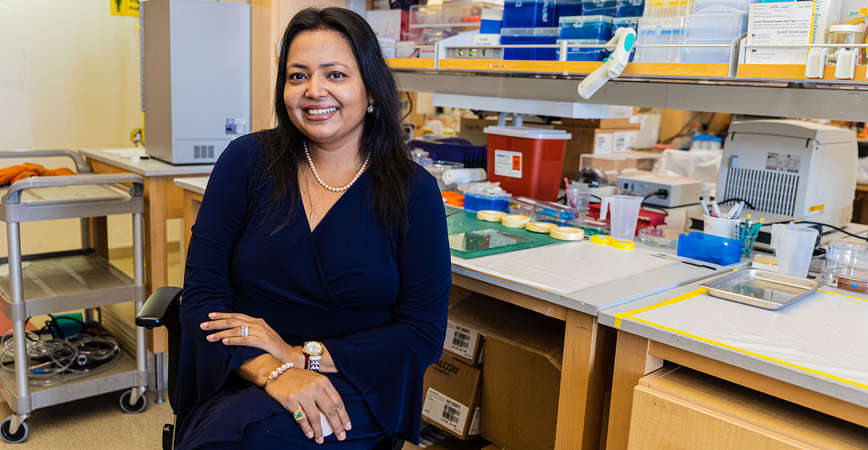
Aparupa Sengupta, Ph.D., was talking to her staff when her phone rang. It was the police chief. Could she join him today for a working lunch?
On that warm, cloudless February day in 2020, the thunder of a growing health crisis was ominous but distant. Two days later, a man in Seattle would be the United States’ first reported COVID-19 fatality. Twenty days after that, California Gov. Gavin Newsom would make national news by ordering a lockdown of the nation’s most populous state.
In another 14 months, Sengupta’s father would test positive amid a huge spike of coronavirus cases in India. He would pass away three days later — another soul lost in a pandemic that as of early October had claimed nearly 4.8 million lives worldwide.
However, the global death toll was less than 3,000 when Sengupta, then UC Merced’s biosafety/biosecurity officer, went to the campus police department a few yards from her Environmental Health & Safety office. Executive Director of Public Safety and Chief of Police Chou Her was there, along with Emergency Manager Laura Rodriguez-Mascorro.
As the three ate Chinese take-out, Her laid out the situation as he saw it. COVID-19 was coming, and the university needed a response plan. It needed someone who could pick up threads of early research into the virus, along with the shifting guidance from federal and international agencies, and weave them into information the campus community could act on.
“I think I caught her a little off-guard,” Her said. “She was a little nervous, as I’m sure anybody would be in that position. But I told her I can’t think of anybody on campus who can understand this situation better.”
Sengupta was being asked to take her expertise in biosafety, focused primarily on developing and implementing safety procedures for the campus’s research facilities and high-containment labs, and apply it to a global pandemic. Her reaction?
She was a little nervous, as I’m sure anybody would be in that position. But I told her I can’t think of anybody on campus who can understand this situation better.
“I told him he could count on me. I think I was used to being thrown into the deep end of the pool. Mainly, I was calm. That was something I inherited from my dad.”
In the weeks and months to come, Sengupta collaborated on developing health guidelines and on crafting presentations to executive leaders. After university operations were curtailed in March 2020, sending home thousands, she held safety training classes for staff whose jobs required them to remain on campus.
“I’d come in the morning for the first shifts, like the custodial staff, then stretch my schedule so I could work with the night shift,” Sengupta said. “These people are the most important. They are the most vulnerable ones.”
Over the months, as part of UC Merced's COVID Response Center, she developed protocols for on-campus testing and proper shipping of test samples to UC Davis and UC San Francisco. As the university progressed through the pandemic, she worked on guidance for the restart of lab research and, most recently, the resumption this fall of in-person instruction and support.
“Aparupa was involved with a network of biosafety officers contributing to the emerging guidance, ensuring UC Merced had reliable and timely information necessary to make critical decisions,” Chief Resilience Officer Andrew Boyd said.
Those associations led in part to Sengupta co-authoring a commentary that appeared in August in a peer-reviewed journal edited by Johns Hopkins University faculty. The commentary asserts the pandemic showed how biosafety professionals can not only help schools, businesses and communities weather an epidemic, but can recommend steps such as training and building design to ease the blow of the next epidemic.
“Biosafety consultations during epidemics have been largely ad hoc,” the commentary says, “because prior to the COVID-19 pandemic, no formal mechanism existed for identifying and engaging biosafety professionals to support local pandemic planning and response.”
Sengupta was steered to her chosen profession by her mother, Tanusree Sengupta, an educator with a master’s degree in zoology. Aparupa was aiming for a career in medicine, but Tanusree said biotechnology was an up-and-coming field and her daughter should go for it.
“She’s a woman who always sets her sights very, very high,” Sengupta said.
After earning a master’s degree in biotechnology at Bangalore University, she came by herself, at age 25, to the United States, where she entered Michigan Tech, a research university of about 7,000 students in the state’s upper peninsula. (“The average snowfall there is 200 inches,” she said; to be precise, it’s 218.) There, she earned a master’s in molecular genetics and biotechnology, then a Ph.D. in biological sciences.
I’d come in the morning for the first shifts, like the custodial staff, then stretch my schedule so I could work with the night shift. These people are the most important. They are the most vulnerable ones.



